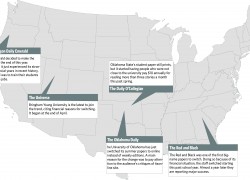
With the rise of the digital age and dwindling print-circulation numbers, newspapers across the country have been forced to shut down or remodel to keep afloat.
Some big-named college newspapers and even some professional newspapers have begun to shift their focus from print to more of an online presence. The 175-year-old New Orleans Times-Picayune will now print three days a week, and the 92-year-old U. Oregon student newspaper, The Emerald, will only produce two print editions per week, with editions coming out Mondays and Thursdays.
Ryan Frank, publisher for The Emerald, said when it came to the idea of switching from The Emerald paper to the more digital-oriented Emerald Media Group, the deciding factor was the
University’s mission statement.
“I think the way we looked at it was, ‘How do we meet our mission?’” Frank said. “How do we train our students for the jobs that exist or will exist, and how do we serve the University of Oregon community? And how do we do those things that will be financially sustainable in the short and long run?”
Frank said even though The Emerald had financial trouble in the 2000s, last year was actually one of their most successful. In fact, it was the most the paper had made in over a decade.
That was also the trend with The Red and Black, the student-run newspaper for U. Georgia. In 2011, the Red and Black was one of the first major university papers to switch their focus to online. Julia Carpenter, editor-in-chief for The Red and Black, said before the switch that the paper was “financially reliable.”
A key to the process for these papers’ online success has been the advertisers staying on board.
“I met with a number of clients when we were in the planning stages, and their sort of gut and initial reaction was, ‘If you build something that is more relevant to students and improves my marketing reach on campus, my company spending with you is likely to be the same and may grow over time,’” Frank said. “So what they want is audience, they want eyeballs, they want results. They don’t care if we print on tree bark, they want someone to see their message, absorb their message and take action, and if we’re doing stuff that does that in a positive way, they are going to support that.”
The Red and Black also saw success in the transition of advertisers, Carpenter said. They offer not only more room in a larger 28- to 32-page weekly print edition, but also an online presence.
Carpenter said that the biggest hurdle was for the staff to get used to the increase of online material.
“My staff, when I was a news editor, was very wary of the transition,” Carpenter said. “They had this ingrained prejudice against online stories. You want your stories to be in the paper, you want it to be center beat, you want it to be in actual, physical print, and that was something I struggled with, I think, for the first time as I was news editor more than anything, even as readers were responding.”
It’s not just journalism students who think cutting down print is wrong. Jean McDonald, former sports editor for The News-Gazette in Champaign and journalism professor at U. Illinois, said though college papers have had success, the idea hasn’t hit the professional stage yet because of the uncertainty of the idea.
“Newspapers, especially in the real professional world, are businesses, and they have to make money,” McDonald said. “I would want to know how those papers were being funded before. Were they independent entities that couldn’t make it, or were they funded partiall by the university who said, ‘Hey, let’s try this other format.’?”
Some papers, like The Michigan Daily at U. Michigan in Ann Arbor, remain loyally print-oriented. Joseph Lichterman, editor-in-chief of The Michigan Daily, has had the benefit of financial stability. He also said he doesn’t envision going to an online format because of how students access the newspaper.
“The way people pick us up, we’re still in all the buildings on campus, and people still want to pick up the paper on the way to class,” Lichterman said. “I can’t see us doing what they did in Oregon or anything like that going digital-only anytime soon.”
Like The Daily Illini, The Michigan Daily and The Red and Black are both student-run and do not receive any money from their universities. Along with The Michigan Daily, The Daily Illini will continue to print five days a week come the fall semester.
After a full year under the online idea, The Red and Black has seen major success.
“It was getting my staff to understand that the story online gets more views,” Carpenter said. “More people read it than in an actual paper. Our print paper has a circulation of thousands. Our online has the circulation of millions. Millions of people can read your one story. That is more valuable.”
